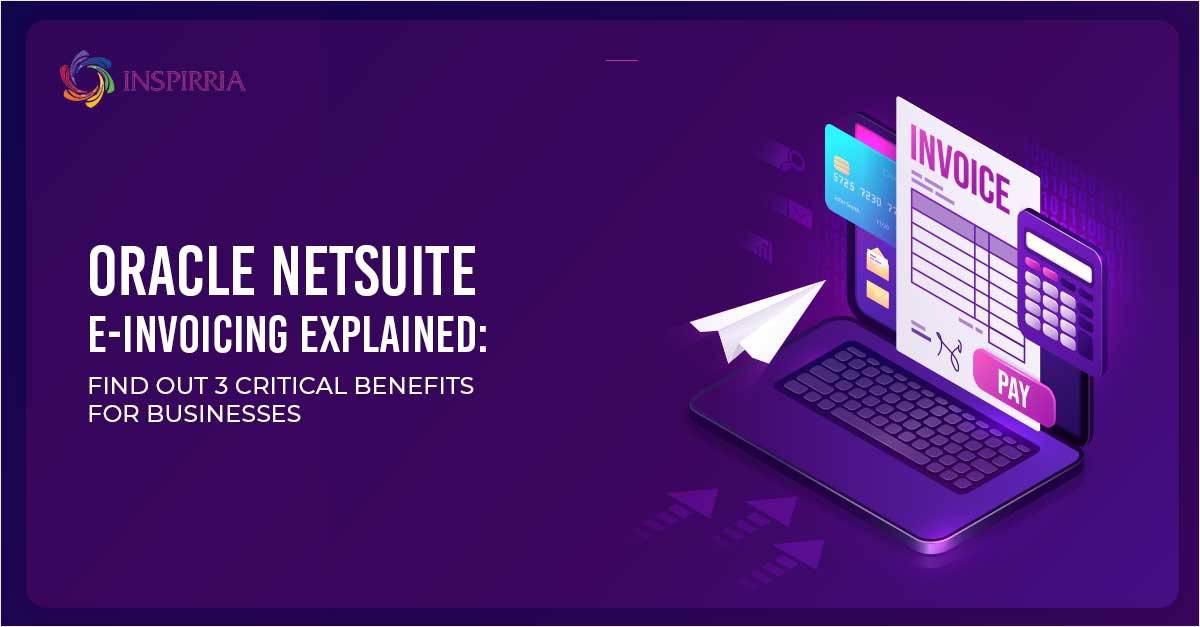You are here
Oracle NetSuite E-Invoicing Explained: Find Out 3 Critical Benefits For Businesses

Traditionally, generating invoices, sending those invoices to the customers, and then making sure that the payments are being made for those invoices have been a time-taking, and labor-intensive process, depending on manual efforts, and prone to critical errors.
With Oracle NetSuite Electronic Invoicing or E-Invoicing, this problem is resolved once and for all.
In this blog, we will give an overview of the Oracle NetSuite E-Invoicing, and share the stunning benefits of using this feature.
And find out how Oracle NetSuite is empowering businesses with E-Invoicing.
What Is E-Invoicing By Oracle NetSuite?
In layman's terms, Electronic Invoice or E-Invoice is a digital invoice, which contains the billing information in a digital structure, and is transmitted electronically from the supplier (who is providing services/products) to the customer (who is making the payment for those products and services).
And the best part? An E-invoice can also be used to make payments, and this changes everything.
How Does E-Invoice Work?
Let’s assume Adam’s Pet Food, a manufacturer of pet foods, is selling products worth $1000 to a retailer called Howdy’s Pet Retailer. With an e-invoice from Oracle NetSuite, Adam’s Pet Food’s account receivable will automatically generate an invoice for $1000 and share electronically with Howdy’s Pet Retailer.
Now, as soon as the invoice is sent, Howdy’s Pet Retailer’s accounts payable system will directly import this invoice, match it with the original purchase order, and confirm if the shipment worth $1000 was received or not.
Once everything is matched, Howdy’s Pet Retailer can either automate the payment (with the details shared in the invoice) or manually make the payment.
As we can observe, almost everything is automated, streamlined, and optimized when it comes to generating an invoice, sharing the invoice, and checking the invoice for making the final payment.
Nothing short of magic, thanks to Oracle NetSuite!
Types Of E-invoice from Oracle NetSuite
Some of the examples related to e-invoice can be (but are not limited to..)
Sales Invoice
Past-Due Invoice
Credit Memo
Pro forma invoice
Debit Memo
Mixed Invoice
Commercial Invoice
Timesheet Invoice
Interim Invoice
Final Invoice
Recurring Invoice
And more.
Benefits Of E-Invoice By Oracle NetSuite
- Removal of Manual Tasks & Errors
With e-invoice, most of the manual tasks such as matching the invoice with a purchase order, generating an invoice, sharing the invoice, payments, etc can be automated, completely eliminating the need for manual work. And this translates to fewer errors since most of the processes are based on Cloud computing and the business logic created by the business.
- Enhanced Productivity
Since the accounts team and other team members are not required to manually enter the details and check them, the overall productivity of the company increases, as the team can now focus on the core business activities, and help the company to generate more revenues.
-Enhanced Cash Flow
As observed by our team at Inspirria, when we deploy e-invoices for businesses, then the overall cash flow improves by a considerable amount - payment cycles get reduced, the customers can get the invoices in a timely manner, and in turn, they make the payments faster.
Indirect advantages include protecting the environment since there are no papers involved.
Key Benefits :
- We offer a bulk e-invoicing option to generate multiple e-invoices in a single click, making the process more efficient.
- We are also providing GST tax invoice print layout changes as per user expectation for IRN/QR code.
- Our system includes an e-invoicing cancellation button, providing a convenient and efficient way for users to cancel invoices.
Connect with Inspirria to find out more benefits of opting for e-invoice, and how can your business leverage its amazing features, right now!


